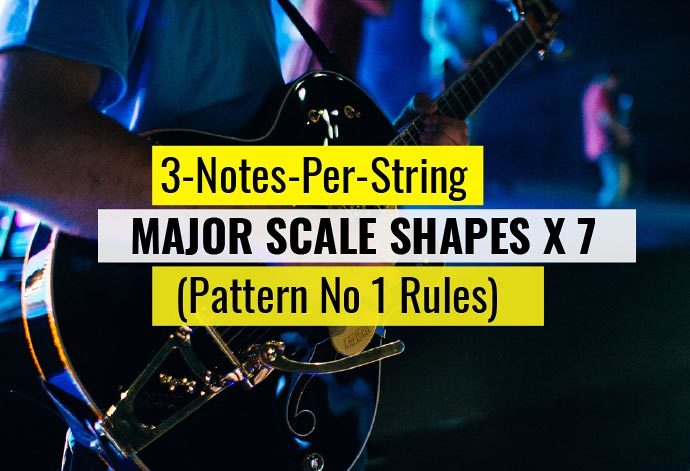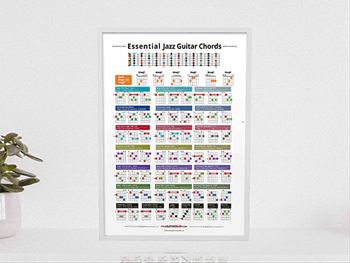The 7 three-note-per-string major scale guitar patterns – Beginner-friendly lesson | Learn to play the guitar faster & better.
In this lesson, you’re going to learn the seven 3-notes-per-string major scale shapes. Are you looking to improve your guitar playing?
You’re in the right place. Because for any guitar player looking to upgrade your playing skills, scales are your best friend.
To maximise your guitar-playing gains, it’s a good idea to learn as many different ways of playing a scale as you can get your fingers around.
When you know multiple scale patterns, you’re not limited to just one way of playing a lick, solo, or arpeggio. This gives you more freedom to express yourself musically.
For example, you can use different scale patterns to create different rhythms, melodies, and harmonies.
Table of Contents
Benefits of the 3-Notes-Per-String Shapes
So what are the 3-notes-per-string major scale shapes (3NPS)? These scale sequences are patterns that give you an alternative way of mapping out the major scale notes on the guitar fretboard.
Popular with lead guitarists, 3-notes-per-string scale shapes give you extended fretboard note access without having to move your hand around too much.
As a result, this enables you to achieve economy of movement, hone your technique, and ramp up to impressive playing speeds.
3-notes-per-string scale shapes enable you to achieve economy of movement, hone your technique, and impressive playing speeds.
Before we get to the 3NPS scale patterns, let’s have a refresher on the major scale.
What is the Major Scale?
The major scale is the daddy of all scales and is one of the scale patterns beginner guitar players should learn first.
What’s the big deal with the major scale? I can almost hear you thinking.
The major scale is the swiss army knife of guitar scales. It can be used to play any type of music, from rock and roll to jazz to classical.
It is also the foundation for all other scales, chords, and melodies. If you want to be a well-rounded guitar player, you need to know the major scale inside and out.
The happy-sounding major scale (aka the do, re, mi, fa, sol, la, ti, do scale) contains seven notes and has the interval formula:
1 – 2 – 3 – 4 – 5 – 6 – 7
The scale is made from a series of fixed intervals of whole steps (tones), and half steps (semitones), like so:
Tone – Tone – Semitone – Tone – Tone – Tone – Semitone
Here’s another way you’ll see the major scale intervals presented, where W = whole step and H = half step:
W – W – H – W – W – W – H
Now you’re up to speed on a few ins and outs of the major scale, let’s dive into the 3NPS major scale patterns.
As usual, with scale box positions, all of the patterns are totally movable. So, move them up or down the fretboard and play in whichever key you want.
Many guitar players believe an added bonus to the 3-notes-per-string scale patterns is they can be easier to memorise.
See what you think.
Limited-Time Offer! Save 15% on Essential Jazz Guitar Chords Chart Digital Poster
Start learning to play 65 of the most used common jazz (blues, funk and country too) chords + bonus guitar fretboard notes chart fast without waiting for shipping ⇩
Jazz Guitar Chord Shapes Include:
✨ Major seventh (Maj 7th)
✨ Minor seventh
✨ Dominant seventh
✨ Diminished – Half Diminished
✨ Major 9th / minor 9th / dom 9th
✨ Maj11th / minor 11th / dom 11th
✨ Maj13th / minor 13th / dom 13th
and more…
The Seven 3-Note-Per-String Scale Patterns
Breaking a scale up into seven shapes (instead of the usual five scale patterns) can be a helpful way to learn the scale. Each shape starts on a different scale degree, which means that you can play the entire scale from any position on the fretboard.
In the key of C example below, the fifth scale pattern down is actually shape number 1. This is because the lowest note in this pattern is the C root note.
I chose to start with shape 4 in the diagrams above because it is a good starting point for learning the 7 scale shapes. It is also a very versatile shape that can be used to play a variety of licks, solos, and arpeggios.
Let’s get to the patterns.
Scale Shape 1 | Pattern 4 in C Major
This scale shape is the fourth pattern in our example key of C major because it starts on F, which is the fourth note (aka degree) in the key of C major.

Scale Shape 2 | Pattern 5 in C Major

Scale Shape 3 | Pattern 6 in C Major

Scale Shape 4 | Pattern 7 in C Major

Scale Shape 5 | Pattern 1 in C Major

Scale Shape 6 | Pattern 2 in C Major

Scale Shape 7 | Pattern 3 in C Major
5 Scale Practice Tips + Exercises
Let’s get to some practice tips to make light work of your scale practice.
Practice Tip #1 – Break It Down
Don’t think you have to go into overload mode and attempt to memorize all of the patterns in one fell swoop. Learning at least one or two is a wise move that’ll stand you in good stead for the future.
I recommend starting with pattern number 1, considering it starts on the root note. (See the TAB below).
Your finger stretch will improve tenfold when you throw a 3NPS pattern into your practice regime.
Fingerings: When playing the scale shapes, the numbers in the circles tell you which finger to play the note with:
1 = first (index)
2 = second (middle)
3 = third (ring)
4 = fourth (pinky)
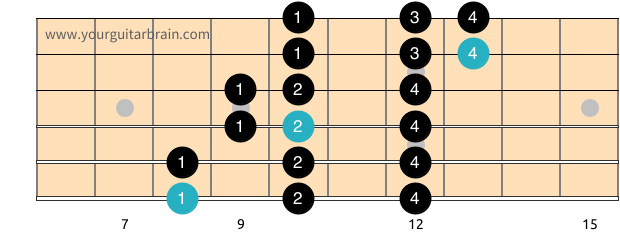
Fig. 1.2 – Suggested fingerings used in 3-note-per-scale pattern 1
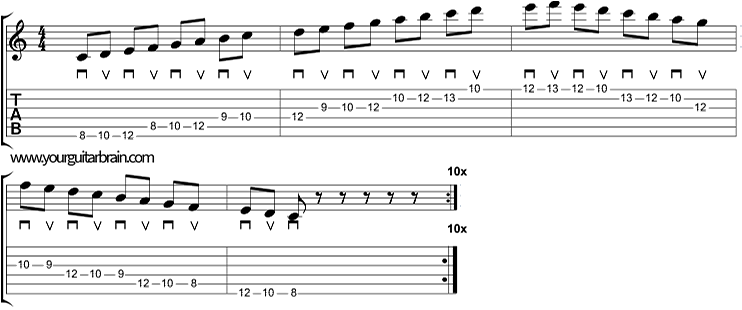
Fig 1.0 – 3-notes-per-string major scale pattern 1 – Alternate picking direction shown
Pro Tip
Experiment with using fingers 1-3-4 on the E and A string two whole step stretch, as some guitarists prefer. I personally use fingers 1-2-4. The trick is to decide quickly which fingering works for you - then stick to it. It's important to consistently use the same fingers when playing scales to avoid slowing down your progress.
Practice Tip #2 – Picking Direction
Many guitarists use economy picking on 3NPS patterns. That is to say, they pick Down-Up-Down on the starting string, then Down-Up-Down on the next.
(See the tablature below in Fig. 1.1 where the economy picking stokes are illustrated above the tablature staff).
They believe playing two downstrokes in a row as you change strings helps you gain playing speed.
I advise you to stick to alternate picking until you become familiar with and proficient at playing the shapes.
With practice and good technique, you can shred as fast as you like with alternate picking. Check out guitarists like Paul Gilbert if you need proof.
At the end of the day, experiment with both picking techniques and stick to what feels natural to you. (See the TAB above in Fig. 1.0 where the alternate picking stokes are shown above the TAB staff).
Pro Tip
Don’t randomly change between economy and alternate; choose one and stick to it.
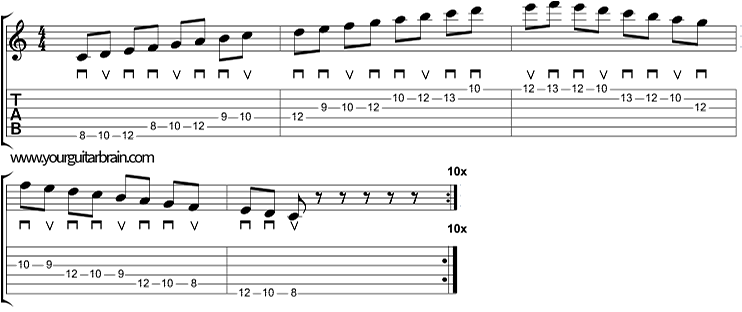
Fig. 1.1 – 3-notes-per-string major scale pattern 1 – Economy picking direction shown
Practice Tip #3 – Focus On Technique
Remember, good technique should always be your key practice goal. See this article for some effective practice tips to help you improve fast and avoid wasting practice time.
Practice Tip #4 – Watch Your Timing
Use a metronome to keep your rhythm steady, starting at a slow speed and gradually increasing the tempo as you become more comfortable.
Once you can play the scale accurately at a slow tempo, start practicing with a backing track. This will help you learn to play the scale in a musical context.
Exercise Variations:
1) Tempo Change – Gradually increase your metronome speed in increments of around 5bpm. Play reps of 30 seconds, 60 seconds and/or 2 minutes in each tempo.
2) Change Key– 6th Root: Once you have the scale nailed, playing the scale shape forwards and backwards, try playing in different keys.
Play the 6th string root patterns in these keys: C (fret 8), B (fret 7), A (fret 5), G (fret 3), and the big stretch, F (fret 1). Practice other keys when you see fit.
3) Change Key – 5th Root: Practice the 5th string root scale patterns in these keys: F (fret 8), E (fret 7), D (fret 5), and C (fret 3) to start with. Add on keys further up the neck when you see fit.
3) Randomise – When applying the scale to music and improvise, play the notes in different orders.
Free Backing Tracks
This first audio track features the 3-notes-per-string C major scale pattern one played at 50 bpm. Play along to the track using eighth-note values.
Use this practice track as a warm-up piece to add to your practice routine. Watch that picking technique.
In this second audio track, the scale is played at 60bpm. Practice playing the first octave of the scale before adding on the rest. Focus on good timing.
The two-octave 3NPS major scale is played on the third audio track at 70 bpm. Playing cleanly will feel tricky if you’re a beginner player, so stick to the slower tempo tracks and work your way up.
This final fourth audio track is played at 125 bpm. Don’t attempt this speed unless your playing technique is solid. There’s no point in playing fast if it sounds messy and inconsistent.

